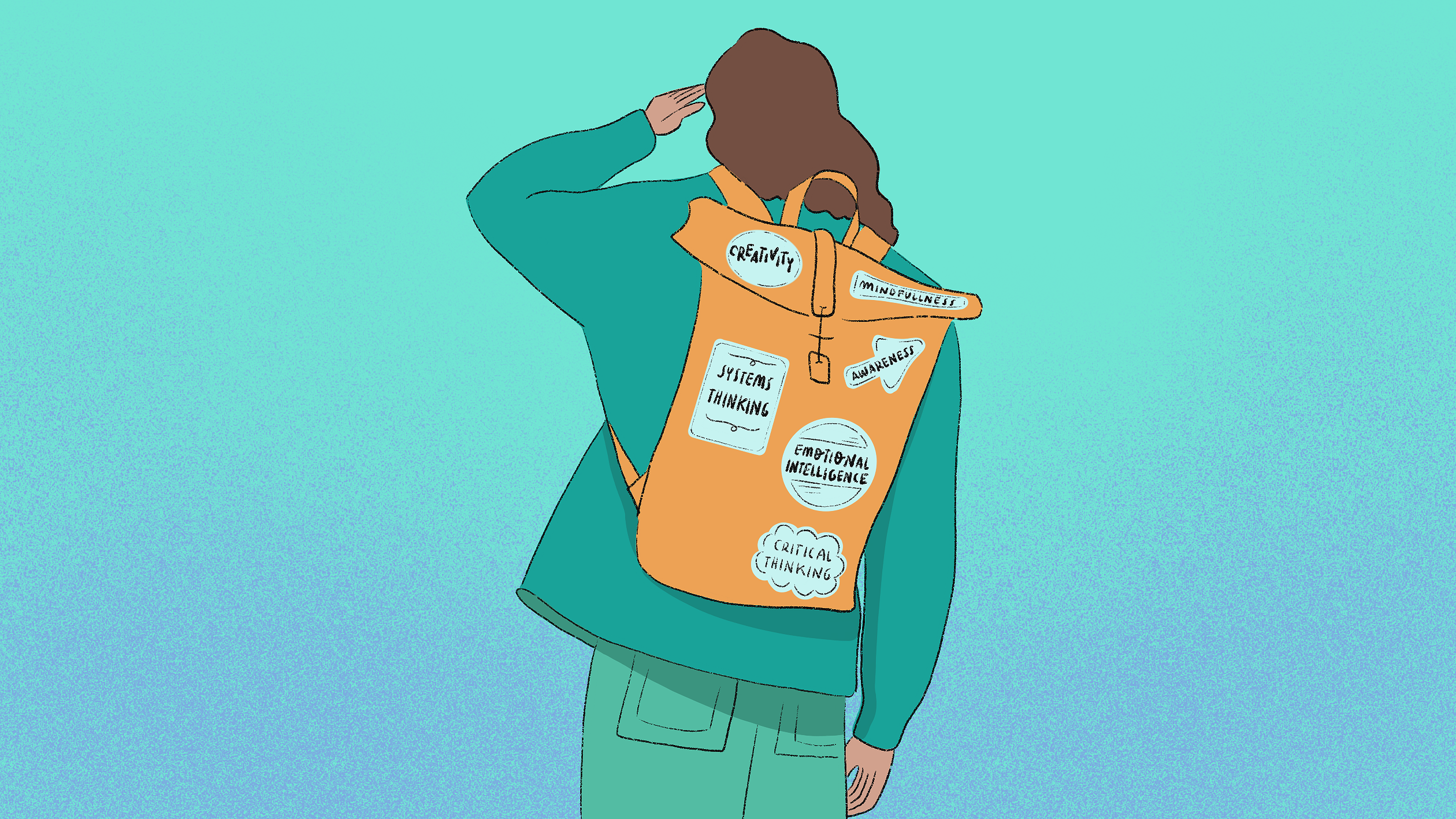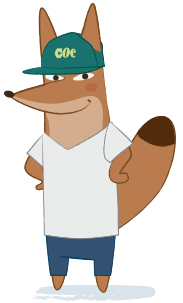
Illustration by Daniela Nunes
Ecoliteracy: competencies of the present and the future
by Erika Kármán
When was the last time you were alone in a completely natural environment, walking in the woods or sitting by the sea? Was it yesterday? Years ago? Never?
We are all part of nature, we belong to nature!
Ecoliteracy is a term that can be interpreted in many ways and is challenging to define in one sentence. For the purpose of this article, we will define ecoliteracy as the ability to understand the natural systems that make life on Earth possible. Eco-science, eco-intelligence, understanding nature and the ecological approach are all part of it. We, humans, are part of a complex system that has worked in harmony for hundreds of thousands of years. One of the reasons for this is that its elements are related, connected and depend on each other. In this ecosystem, we cannot separate ourselves from other living elements, like animals, trees, plants, or even the air, water and soil. There are many signs of isolation that can lead us to a vague understanding of the consequences of human intervention in environmental processes that have sustained life on this planet for millions of years.
 Our current challenges
Our current challenges
When we feel connected, we do not harm our immediate or distant environment. This is because, according to simple logic, we would be harming ourselves. And why would we do that? This systems approach naturally extends this interconnectedness not only to animals, but also to plants and inanimate matter such as water, minerals or air. Although we agree with all these facts, we are becoming increasingly disconnected from our environment and from each other.
We are building an environment around us in which there are fewer and fewer living “things” – compared to the total possible diversity. In recent years I have been in many cities where I had to walk several kilometres to discover a small piece of land and its associated living systems. So it is difficult to feel like an integral part of nature on a daily basis.
The other interesting phenomenon is that humanity has reached a level of consciousness where we can observe and understand what is happening to us – even on a global level. There are nature-connected tribes who live as part of a rich and interconnected biodiversity. However, they do not live this way because it is their choice after considering many aspects, or because it has proved to be the most exciting after many spiritual experiences, but because it is the only reality for them, the particular community they are born into and its norms of living in co-operation with nature. What they clearly understand is that if they do not respect and be humble towards their environment, they will not survive.
We are living in an age in which, due to human creativity and readily available resources, we have a great potential to destroy natural systems, as well as to raise awareness of the importance of the ecological approach to thinking on a global scale. Of course, in a materialistic world, this is not a small sacrifice, but never before in history did we have so much freedom of choice. Choosing “well”, towards a sustainable ecosystem, would mean sacrificing our “comfortable” lives and drastically reducing our consumption. Are we, are you, ready for that?
 Education – a crucial element of the next steps
Education – a crucial element of the next steps
In order to better understand what is going on “outside” and how it impacts us “inside”, we will need to improve ourselves in many aspects of our lives. Daniel Goleman, best known for his research and development of social and emotional intelligence, has extended his basic approach to ecological intelligence, which is based on systems thinking, empathy and connection with nature.
According to Goleman, these are the steps towards the development of ecological intelligence, or ecoliteracy (Goleman, Bennett and Barlow 2012).
1. Develop empathy for all forms of life: We are not the only ones who have similar needs on this planet. Once we start to identify ourselves other than as separate and superior humans, we can develop a much higher level of empathy towards other forms of life. We rely on each other.
2. Embrace sustainability as a community practice: One plus one is two, but two is almost more valuable as it strengthens the sense of community that provides more opportunities, relationships and joy.
3. Make the invisible visible: If it is ugly, but distant and we do not “see” it, it is not even such a big problem... Our system supports the hiding of the inconvenient parts of its operation, so we do not have to see the consequences, to feel guilty about it. We must go all the way to the end of the line and see “all ugly” parts and make decisions on our everyday life choices, mainly on what we buy and how we use goods.
4. Anticipate unintended consequences: Technological innovations are great and appreciated by those who believe in infinite development. We can live a very comfortable life today thanks to most of the inventions of the past centuries. But are we aware of their long-term consequences to us and to our environment?
5. Understand how nature sustains life: Life is always the co-operation between smaller and bigger parts, animals and organs. If they connect there is life, if they cannot co-operate, life is gone. Just like in soil, human bodies or communities. This is the simplest, but the most important pattern we learn from nature.
What could be the most effective way to bring about positive change, if not education? In 2022, the result of years of research and the dedicated work of many experts, GreenComp (the European sustainability competence framework) was born. This is an essential document for all levels and forms of education. However, there is a significant question: do we have enough time to wait until all students learn this? For me, non-formal learning offers the hope that these attitudes, knowledge and skills can be transferred from young students to elderly people earlier and with a different methodological approach to traditional education systems. This knowledge and approach is important for everyone, regardless of age, and everyone needs to take steps to develop it in the hope of a more sustainable future so that social change can happen as quickly and consciously as possible.
 Ecoliteracy in youth work
Ecoliteracy in youth work
Many of us youth workers understand the urge – even for a long time – but the question of where and with what to start is not obvious. Based on an Erasmus+ training course for youth workers called Building Ecoliteracy, we identified the most important competence areas to start with.
Awareness and mindfulness: In today’s world, we are exposed to hours and hours of incoming information as we go about our business, our studies, our work and even our leisure time. Most of the time we hear and read about things that are not really part of our everyday lives, such as events in the other half of the world, eco-political data, or even insignificant details of celebrities’ lives. It is important to be able to distance ourselves from these sources of information on a daily basis and to live our reality, to be aware of what surrounds us, what directly affects us. There are many meditation and mindfulness practices to train this state of awareness. Ideally, we should not only dedicate a few minutes a day to this state of mind, but we should also be able to be in the present, in the here and now, as we go about our daily tasks, in our work, or in our social interactions. In this state, we are also more aware of the environment around us, whether it is a city or a forest, and we are better able to connect with the real (and not imaginary) elements, to notice “each other”, whether human or other living beings.
Emotional intelligence: The integration of emotional intelligence is also a very important element in the development of ecological intelligence because the ability to express our own feelings and be self-reflective gives us the opportunity to articulate the emotional aspects of our connection with nature and to make them clear to ourselves and others. According to the deep ecology approach, we bury deeply within ourselves the instinctive negative emotions we accumulate when we (usually) unconsciously destroy our environment. Confronting and embracing these emotions is only possible at a higher level of emotional intelligence, which we can develop and explore in whole new ways when we do so from an ecological perspective.
Systems thinking: It encompasses all of Goleman’s points. On the one hand, the current ecological crisis is global, so it is as important to understand local systems as it is to understand the global context, because everything affects everything else. On the other hand, the systems approach goes far beyond the systems created and operated by humans. We could go further, of course, but just understanding the complexity of these systems and their interdependence will provide many significant insights. Goleman’s third point is closely related to this skill: with this knowledge and insight, we are able to understand the invisible origins of (almost) all problems.
Creativity: The unique ability of the human species – neither animals nor (as yet) artificial intelligence is capable of the level of creativity that we humans possess. Creativity can be put at the service of progress, of technical innovation, but also of finding solutions to the challenges of the future.
Critical thinking: It is essential in a world that is so stimulating that it affects our emotions. Filtering out the right information, recognising the signs of greenwashing and incorporating ecological value filters into our thinking helps us to navigate and make more confident decisions that affect our own lives and the environment.
For us, who work with young people, we have a key role and responsibility in taking quick steps towards integrating the ecoliteracy approach into our everyday work. Youth work has the power to tackle the development of these competencies with a great variety of non-formal educational methods and approaches. The hope of raising an ecoliterate generation for a more sustainable future depends a lot on this sector.
What can a youth worker, a project manager or a trainer do?
- when you design educational processes, always integrate the sustainability approach – find the connection between your topic and sustainability;
- include the nature connection – even in the city, meet people in natural surroundings;
- encourage green travel for participants;
- search for a venue that provides sustainable space and food;
- be a role model with your sustainability choices.
We have no time to blame others for the current situation, but we have time to learn how to become more ecoliterate every day and inspire others for the same.
The future is not out there in front of us, but inside us.” Joanna Macy
 References
References
Goleman D., Bennett L. and Barlow Z. (2012), Ecoliterate: how educators are cultivating emotional, social, and ecological intelligence, Jossey-Bass, San Francisco, CA
GreenComp: the European sustainability competence framework (2022), https://joint-research-centre.ec.europa.eu/greencomp-european-sustainability-competence-framework_en
Macy J. and Brown M. (2014), Coming back to life, New Society Publishers, www.joannamacy.net

Erika is a youth worker with sustainability focus in her projects.


